Last summer my son started asking lots of questions like “What did people do before there were shoes?” and “Where did people live before there were houses?” That let me know that it was time to start learning history! Being that I love the classical model of teaching, I knew that I wanted to teach him history chronologically and that I wanted to do it by reading living books and incorporating memory work.
At the beginning of the year we started out learning about creation by reading stories, adding events to our timeline, and doing activities that would help him remember what we were learning. I put the plan together, researching books to read and activities to do. I love this kind of planning, but I was finding that it honestly just took too much time! As we were finishing up learning about ancient Egypt, I knew that I wanted to look for another option.
What I Love About Veritas Press History
I looked at many different options and nothing quite fit what I was looking for…until I stumbled across the Veritas Press website! Their history curriculum looked amazing! It had all the aspects of studying history that I was looking for:
- Chronological study of history
- Timeline of important events
- Memorization
- Activity ideas to go with each section
- Book suggestions for each event
Come to find out it even incorporates things that I didn’t know I wanted, but now I do…
- Memorization through SONG
- Timeline CARDS
- A wall-sized map of the area
We wanted to teach history chronologically. We wanted children to
understand the work of Providence in history. Children need to learn at
an early age of God’s sovereignty and how He has worked in history.
~Marlin & Laurie Detweiler, founders of Veritas Press
This is a line from the informational letter that came with the curriculum. I thought just from looking online at the curriculum that I would like it, but after reading this, I knew I had found something I would love!
How We Use the Veritas Press Curriculum
Timeline Memory
The backbone of the entire curriculum is the timeline. The timeline shows up in the memory song, the flashcards, and the lesson plans. Each week you study one card, moving on to the next one the next week. We listen to the song (or sing it ourselves now that we know it) almost every day, flipping through the timeline cards as we sing. I think the aspect of it being auditory and visual has really helped my son learn the order of events really well! I catch him singing the song to himself all the time!
My son loves to look through the cards on his own and having him put them in order is a great activity for him. This is an amazingly effective way of cementing the events in his mind as ‘pegs’ for him to hang future learning on when we re-visit the time periods in the dialectic stage.
Timeline Cards
There are 32 cards in each curriculum set, and they have everything you need to know on them. Each card has a wealth of information on it and if you look closely at the picture above, you can see what I’m referring to.
On the front:
- Name of the event (this is generally what you sing in the memory song)
- Picture to help your child remember and learn
On the back:
- Card number (upper right hand corner) so you can keep your cards in order
- Date (or date range)
- Yellow info box – telling you the most important things about the event/person
- Yellow Resources box – telling you which books to read for that card (even specifying the relevant pages in books that are about more than one event)
- Overall card number (bottom right hand corner) telling you where this card would be placed if you had each set of history and Bible timeline cards that Veritas Press offers
I read the information in the yellow box out loud at the beginning of the week and then pick a few of the resources (from the yellow resources box) to read on other days of the week. Then I look at the date and help my son put the event/person in the correct place on our wall timeline.
Something else I decided to do was to make a condensed version of each card’s yellow information box to use as a memory sentence for my son. We learn the sentence all week long and then review the old ones as well.
Map and Wall Timeline
There are two optional resources included in the curriculum: a wall map and a wall timeline. The only downside is that you have to piece the map together because it is on multiple pages in the book (or PDF if you have the CD). I decided to lightly color the map (water blue and land brown) just so that my son could more easily understand it. Once I did all that, I laminated it and hung it on the wall at a height that he could easily see.
If you look closely at the map, there are little dashed circles with numbers inside of them. These correspond to the card numbers. Each week my son puts a little picture in the circle that helps him remember the card and also learn where that event took place. Seriously, this curriculum is amazing. It truly has it all.
I love catching my son just standing and looking at the map. He discovers new things each time he looks at it and looking at it so much (since it’s right at his level) helps him solidify things that we have learned. When he looks at it he will say things to me like, “Mom, Crete has water all around it, so I know that it’s an island.” or “I bet the Greeks traded with the Egyptians because they are right across the Mediterranean Sea from each other.” I love it!
There is also a timeline that you can either hang on a long wall or put in a binder. It looks nice, but honestly we didn’t use it since we had already started a timeline earlier in the year.
Activities
To help your child understand the information a little better, the Teacher’s Manual is filled with activities, extra stories, notebooking pages, and discussion questions (oh yeah, and questions for tests if you want to do that!)
You can do everything they suggest, pick and choose ideas that fit your child’s interests and abilities, or just use their suggestions to come up with your own ideas. I love doing at least one activity per week to help engage my children and pique their interest. Some of the activities (and especially the writing involved with the questions) are above my children’s abilities, so I just don’t do them. Even so, I have found plenty of ideas in the manual to keep us busy each week! Below is my three-year-old daughter joining in as we made pottery like the Minoans.
Something I chose to do was put together a notebook for my son to keep all of his papers and projects together in one place. If we do a larger activity, I just take a picture of it and glue it into the notebook. I also include copywork and any coloring or notebooking pages that we do for the week. Here is a video of my son showing you this notebook and talking a little bit about what he has learned so far about Ancient Greece…
This curriculum is technically designed for 3rd graders, but I love that it can be modified for any age in the grammar stage and can definitely be used for teaching multiple ages. My son is at about a K-1st grade level and it is still perfect for him. If all he does is memorize the timeline order and remembers one thing about each person/event, he will have an amazing foundation for further studies as he gets older.
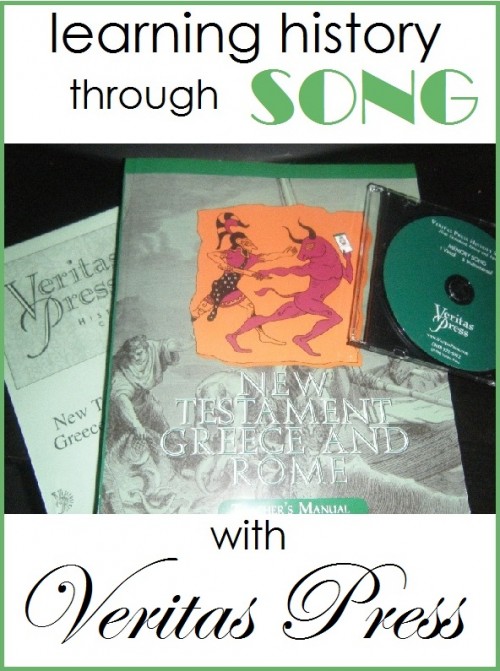
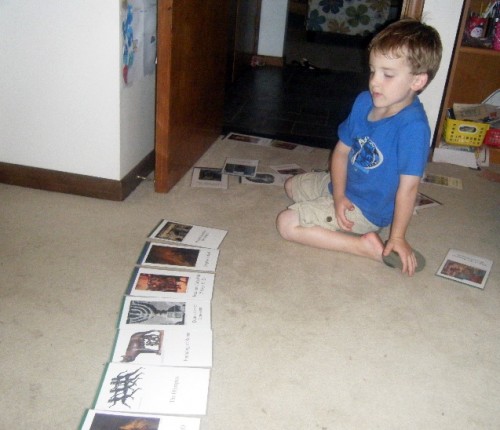
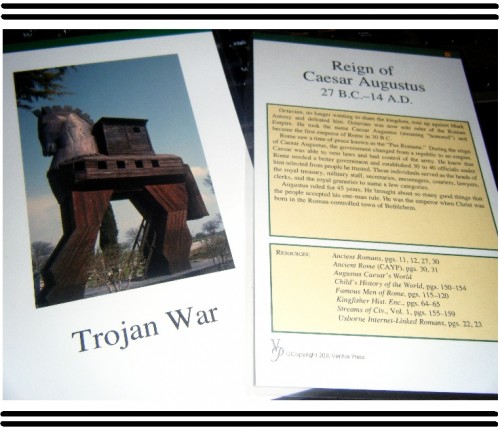
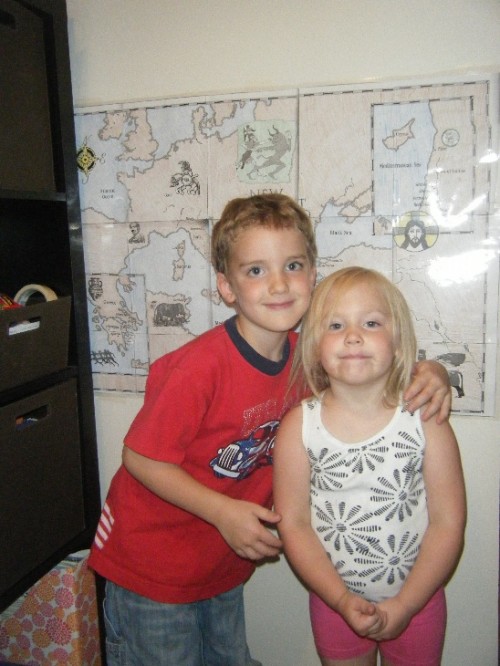
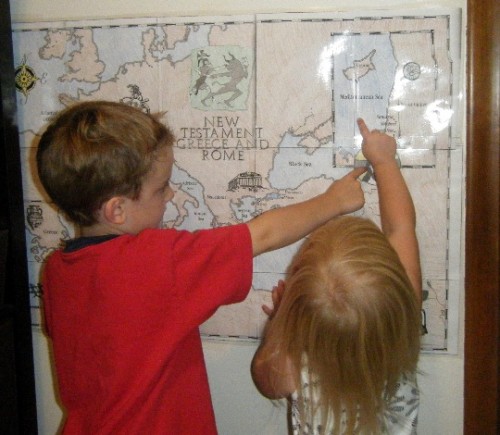
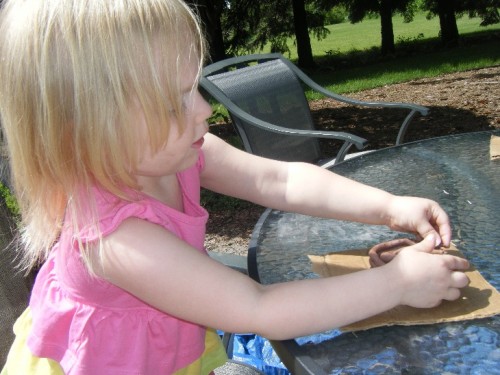

What is the memory song CD like? Does the song just list the events in chronological order? or does it include dates too? If dates, only a few here and there or a date for every card? Any other info included in the song?
Good question! Did you watch the video I posted? My son sings a little bit of the song around the 6 minute mark (or so). It is mostly “1st the…., 2nd the…3rd the… etc.” Some of them also say the date, but not all of them. For instance “8 was the founding of Rome, in 756BC” Obviously the physical cards have every date on them, but every date is not included in the song.
I really do think it’s very helpful. The order of events will forever be in your mind, and there are enough dates to be able to place things pretty well on a timeline. They are great ‘hooks’ to have in your child’s mind for them to be able to hang more info on later.
Hope that helps! Feel free to ask more =)
Hi Amy,
Thank you for this post! I have been seriously thinking about VP history to use with my soon to be 5 yo DS in about a year or so…this helps me make that decision. I appreciate all of the information you shared!
I loved the book you put together for Trevor. Did you have to make all those pages or did they come with the Veritas Press curriculum? Did you follow a specific order for each timeline card? Does it include a narration of history similar to story of the world or is it very different?
I used this with my kids ages ago and loved the little song they had to memorize the days of creation – “Day one, day and night. day two,,,’ I have been trying to remember the lyrics to the last part of this after “Then God saw all He had made; it was very good.” Would you help me out by posting the lyrics to this song? I would be so grateful!